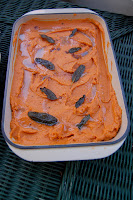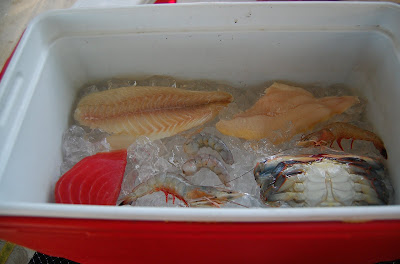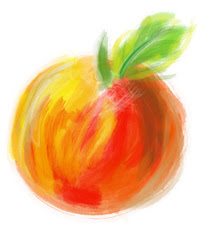Monday Morning Coming Down
I just ate lunch. Not exactly breaking news, but in the glutted days after Thanksgiving, lunch takes on a halcyon character: a turkey sandwich here, a nibble of stuffing there. (By the way, down here in Dixie they call it dressing and often make it from cornbread. I will never do either.) Delight, already cooked, greets me every time I open the fridge.
In fact, today's lunch included turkey liver pate, not on the Thanksgiving menu but a by-product thanks to the fact that our West Wind Farms turkey came with gloriously intact, fresh giblets. (Sounds a little naughty, no? Well, I guess this is food porn.) I used a recipe for chicken live pate from the yellow Gourmet cookbook, but tarted it up with cream and extra soft butter worked in at the end to compensate for the fact that the free-range bird's liver isn't as rich as those coddled chickens'. I subbed some of my husband's high-end bourbon for the indicated cognac. A salutary shift, may I say, and harmless as it cooks off.
Remember my ugly pears? A few of them, transparent with sugar, top my upscale offal. Edna Lewis, in The Taste of Country Cooking, praises the "meaty texture" of these preserves. She's right. I can't eat Kiefers raw, but the alchemy of heat and sugar turn their grainy, unyielding flesh into a toothsome bit of caramel and a perfect foil for gobbler foie. The nutty sweetness also brings out the best in softy, rindy cheeses.
After I munched 6 or so of these morsels, I remembered my roasted cranberry-apple chutney, a riff on this epicurious recipe, but minus the butter and o.j. and plus clementine sections and crystallized ginger. I also subbed shallots for the onion. I don't know which I loved more desperately atop my pate, but I might have to do it all again tomorrow.
Swee'potatoes 3 Ways
Our good friends the Murphys hosted a Thanksgiving dinner for 12 adults and 8 kids. We brought the aforementioned cran chutney and turkey, Shoaf's Loaf rolls, mixed braised greens, 2 pans of sweet potatoes, and pie.
Not any pie--sweet potato pie, tart with buttermilk, airy with egg whites. Actually, I made 2 pies, the first of whose crust was flaky and rich with lard that I rendered from a pork shoulder I roasted a couple weeks ago.
Delicious (both the pork and the piecrust), but I was so excited by this fatstravaganza that I spaced out and worked 4 oz. instead of 4T. lard into my dough. I think the technical term for the resulting structural failure is pastry slump. Fortunately, I had enough batter to fill this piecrust to about tart depth, and kept it home so I'd be sure to have enough for breakfast on Friday morning. I think this is about as close to making a fried pie as I may ever get.
I made my recovery piecrust with half butter and half Spectrum shortening. Perfectly good, and didn't put me in that morally questionable position of bringing a pork-fat pie to a dinner attended by many who eschew the eating of furry beasts.
Yam I Ain't
About those other sweet potatoes. I said 3 ways, didn't I? The pie is #1. The other 2, though traditional, are startlingly delicious, smooth, and rich. Instead of steaming the sweets as for pie, I roasted them till they swooned, then force them through a strainer. (This took forever and I don't recommend it if you have an alternative. My food mill is in storage, and I'm a little nuts.)
Both preparations are luxe with butter and cream. I deepened the flavor of the traditionally tinted orange sweets with maple syrup and topped them with butter-fried sage leaves. Comforting and kid-friendly. The surprise hit, though, was the chipotle-infused purples. Because of all their berry-colored antioxidants, the tubers have a winey flavor that melded seductively with the smoky adobo sweetness of the peppers. There were finger tracks in the baking dish, and no leftovers.
These odd-looking tubers have a fascinating history. Sweet potatoes originated in the Caribbean and Central America and remain primarily a food of the American South. However, the purple sweets I found at Whole Foods are descendants of a variety that traveled with Columbus to Spain. From there, other explorers launched them on an itinerary leading to the Philippines, China, then Japan, where the purple variety emerged. Early Japanese immigrants brought it to Hawaii, and now they're grown in North Carolina for sale in southeastern markets. Whew! I guess that means they've almost circumnavigated the globe.
Sweet potatoes, by the way, are neither yam nor potato, but a usually orange relative of the morning glory. True yams, on the other hand, are white to pinkish-purple starchy tubers from the Old World that can be as big and shapely as a Folies Bergère dancer's thigh.
Soup for Nuts
A steady stream of emails last week from foodie sites conveys the anxiety--and possibility--that clings to a spent turkey carcass as surely as pie-pounds cling to my carcass. Some ideas are better than others. Turkey tacos, okay. Turkey-pear Stilton pie made with prefab crust? maybe, but if it involves buying stuff I don't already have around, maybe not.
Something easy and traditional appeals to me, so I simmered bones, carrots, celery, onions and garlic all afternoon and into the evening, then used the jiggling stock to make a rich, dark tortilla soup from the Lee Bros. cookbook. I hope you made stock too, and will treat yourself to a much-deserved bowl of something soothing in the holiday-hectic weeks to come.
What did you do with your leftovers?














































